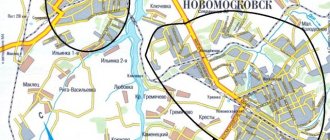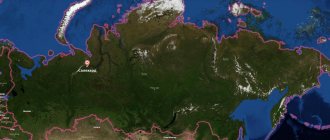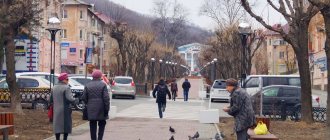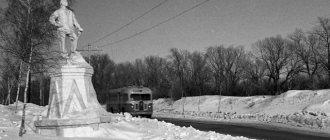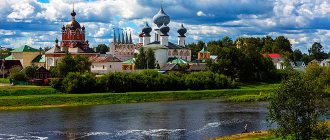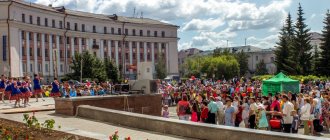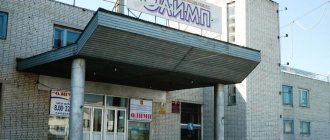Rtishchevo on the map of Russia: geography, nature and climate
Rtishchevo is located on the left bank of the Olshanka River . The Rtishchevo region has a small amount of forests and is surrounded by fields that are used for sowing and growing grain crops.
The slopes that are part of the Rtishchevsky district are of unique importance for the entire Saratov region. Here they have a red tint, which is due to the inclusion of siltstone in the soil.
The city has a temperate continental climate and is characterized by high rainfall. The driest month, according to average statistics, for the year is March, but even in this month the precipitation does not stop, but is a little less frequent than usual. The month with the most precipitation is July.
The warmest month, with an average air temperature of 20 degrees, is July. The coldest month is January; the air temperature during this period drops to -11 degrees.
You can get acquainted with the landscape of the city in more detail by turning to satellite maps of Rtishchevo.
Routes on the map of Rtishchevo. Transport infrastructure
An important part of the railway connection is located in Rtishchevo - the junction of the South-Eastern Railway. Passing directions:
- Saratov - Tambov.
- Penza - Povorino.
There are three railway stations in the city itself:
- Rtishchevo – 1st passenger station, located at st. Zheleznodorozhnaya, 17 in the very center of the city ,
- Rtishchevo - 2 - located in the eastern part of the city,
- Shuklino - located on the southern outskirts of the city.
Two highways of regional importance pass through the city:
- R 208 – provides traffic in the direction Saratov - Tambov.
- R 235 - provides road communication in the direction Balashov - Rtishchevo.
Public city transport is presented in two versions:
- A minibus that runs along a specific route.
- Passenger regular buses.
All routes and locations of public transport stops can be found on the map of Rtishchevo with streets.
Map
| Rtishchevo: maps |
Rtishchevo: photo from space (Google Maps) Rtishchevo: photo from space (Microsoft Virtual Earth)
| Rtishchevo. Nearest cities. Distances in km. on the map (in brackets along roads) + direction. Using the hyperlink in the distance , you can get the route (information courtesy of the AutoTransInfo website) | |||
| 1 | Bekovo (Penza region) | 23 (39) | WITH |
| 2 | Prigorodnoye (Penza region) | 36 () | NE |
| 3 | Serdobsk | 38 (38) | NE |
| 4 | Arkadak | 40 (45) | SW |
| 5 | Ekaterinivka | 44 (53) | SE |
| 6 | Turks | 45 (72) | SW |
| 7 | Tamala (Penza region) | 48 (58) | NW |
| 8 | Umet (Tambov region) | 65 (81) | NW |
| 9 | Kolyshley (Penza region) | 71 (73) | NE |
| 10 | Malaya Serdoba (Penza region) | 82 () | IN |
| 11 | Belinsky | 83 (111) | WITH |
| 12 | Kirsanov | 83 (99) | NW |
| 13 | Inzhavino (Tambov region) | 88 (148) | Z |
| 14 | Balashov | 88 (97) | SW |
| 15 | Romanovka | 89 (134) | SW |
| 16 | Atkarsk | 93 (102) | SE |
| 17 | Kalininsk | 96 (115) | SE |
| 18 | Gavrilovka 2nd (Tambov region) | 97 (122) | NW |
| 19 | Muchkapsky (Tambov region) | 100 (241) | SW |
| 20 | Kamenka | 105 (127) | WITH |
| 21 | Kondol (Penza region) | 106 (116) | NE |
| 22 | Bald Mountains | 106 (139) | SE |
| 23 | Uvarovo | 107 (197) | Z |
| 24 | Petrovsk | 109 (173) | IN |
| 25 | Bashmakovo (Penza region) | 118 (156) | NW |
| 26 | Samoilovka | 118 (170) | YU |
a brief description of
Located on the western edge of the Volga Upland, 214 km west of Saratov. Railway junction lines.
Territory (sq. km): 33
Information about the city of Rtishchevo on the Russian Wikipedia site
Historical sketch
It arose as a village near the railway. Rtishchevo station (opened in 1871); name after the village of Rtishchevo located near it, which was named after its first owner.
Since 1920 the city of Rtishchevo.
Economy
Rtishchevo is the center of an agricultural region. Enterprises for processing livestock products: meat processing plant, butter factory.
Railway enterprises transport. Factories: sewing, absorbent cotton wool. Construction materials plant.
| Population by year (thousands of inhabitants) | |||||||
| 1926 | 11.4 | 1992 | 44.3 | 2007 | 43.3 | 2016 | 39.6 |
| 1931 | 14.1 | 1996 | 45.1 | 2008 | 43.2 | 2017 | 39.4 |
| 1939 | 24.8 | 1998 | 45.1 | 2010 | 42.6 | 2018 | 39.0 |
| 1959 | 32.7 | 2000 | 45.0 | 2011 | 41.3 | 2019 | 38.7 |
| 1967 | 36 | 2001 | 44.8 | 2012 | 41.0 | 2020 | 38.4 |
| 1970 | 37.1 | 2003 | 44.2 | 2013 | 40.6 | 2021 | 38.0 |
| 1979 | 41.1 | 2005 | 43.6 | 2014 | 40.2 | ||
| 1989 | 44.3 | 2006 | 43.4 | 2015 | 40.0 | ||
Sights of the city of Rtishchevo
Despite the fact that the city occupies a small territory, it contains a large number of places that will be interesting to visit not only for tourists, but also for local residents:
- Temple of Alexander Nevsky - founded in 1910.
- “Children of War” is a monument erected in memory of the children who were caught in the Great Patriotic War.
- A cinema that is more than 100 years old - the building of the cinema today houses the Museum of Local Lore of the Rtishchevsky District.
- The Defenders Monument is a memorial erected in Rtishchevo in memory of the soldiers who fought during the Great Patriotic War.
- The monument to soldiers - internationalists - was erected in 1990.
Full information about the location of the city’s attractions can be found by referring to maps of Rtishchevo with houses.
History of the city of Rtishchevo
The village of Rtishchevo arose at the end of the 16th - beginning of the 17th centuries and is considered one of the earliest Russian settlements in the Khopyorye region. Until 1723 it was called Pokrovsky - after the name of the church.
In 1723, by decree of Peter I, lands and lands were allocated to participants in the Northern War in the territory of the future Balashov and Serdob districts. Among them was Major Vasily Mikhailovich Rtishchev, who distinguished himself in battles, and received the village of Pokrovskoye and lands along the Olshanka River into local ownership.
In 1727, the Rtishchevs transported serfs here from their other low-yield estates. From that time on, the village acquired a second name: Rtishchevo - after the surname of the landowner.
In 1794, the daughter of V. M. Rtishchev refused to fulfill the will of her father, who bequeathed before his death all his lands, livestock, equipment, buildings and property to be transferred to serfs without ransom, free of charge and forever. She sold the Rtishchev estate, along with the serfs, to Senate Secretary G.I. Nenarokov (Nenarokomov), from whom the lands, villages and peasants subsequently passed into the possession of the landowner Chenykaev.
The Chenykaevs owned the village until 1917.
Chenykaev, Alexey Mikhailovich is called a writer in various sources. But he was not a writer. But he was once the director of a Saratov gymnasium and once a translator. A.M. Chenykaev came from an old noble family, of Tatar origin, like most nobles of the Saratov province; grandfather A.M. was the first to be baptized around 1750.
A.M. Chenykaev, being a graduate of the cadet corps, spent a long time in military service, where he enjoyed the unlimited patronage of Count N.P. Rumyantsev. It is known that he was not a stranger to literary pursuits. In 1802, his translation from German of Vulpius’s book “The Life and Military Deeds of Generalissimo - Prince Suvorov - Rymniksky” was published in Moscow. But, “A.M. Chenykaev was least prepared to take up the public position of director of the newly established gymnasium: “his entire previous service had nothing to do with teaching activities, having neither a pedagogical education nor the proper tact, Chenykaev, evil tongues say , viewed the position of director as an opportunity to solve his financial problems. And indeed, on the premises of the gymnasium he opened industrial workshops, “in which watchmen worked, relieved of their duties; most of the economic amounts were not shown in the statements; from the amount donated by the merchant Sarantsev for the gymnasium, he took 2,000 rubles for himself without knowledge.” But in the same 1802, the manuscript of N. R. Sudovshchikov’s comedy “An Unheard of Miracle, or the Honest Secretary” (M., 1802), purchased through A. Chenykaev, was published, in connection with which V. S. Sopikov attributed authorship to him. Chenykaev probably studied comedy very well, or rather a caustic satire on the morals of the then administration, he probably laughed a lot, but, obviously, he did his job, and he himself did not want to become an “unheard-of diva.”
Very soon A.M. Chenykaev came into conflict with a group of senior teachers who approved the director’s business expenses. Science teacher Bazilev, language arts teacher Cheodaev and history and geography teacher Sosnovsky refused to recognize the expenses made by Chenykaev as fair. A.M. Chenykaev, knowing about the sentiments of Magnitsky’s trustee, sent him a special report in which he “tried to expose the teachers in riotous behavior, free-thinking and disrespect for their superiors and did not even hesitate to bring false accusations of blasphemy and blasphemy against them.” Magnitsky immediately ordered the teachers to be placed under arrest and subjected to church repentance. The unfairly repressed teachers immediately resigned. Discord in the teaching staff and the arbitrariness of the director had a negative impact on the discipline and behavior of students. Magnitsky instructed the director of public schools in the Penza province, I.I. Lazhechnikov, to conduct an audit of the Saratov gymnasium. Having read Lazhechnikov’s report, Magnitsky will say about the Saratov gymnasium that it is “the most unsuccessful morally in the entire educational district.”
He also pointed out numerous financial irregularities. In August 1823, A.M. Chenykaev was dismissed and settled on his estate in the village. Turks. By the way, in our time the deputy head of the South Eastern Railway track service bears the last name - Chenykaev.
In the village of Rtishchevo in 1800, Andrei Filippovich Leopoldov was born - a local historian, writer, ethnographer, journalist, and the first editor of the Saratov newspaper “Gubernskie Vedomosti”.
Station village Rtishchevo
In 1868, the committee of the Zemstvo Tambovo-Saratov Railway alienated the field plots of the peasants of the village of Rtishcheva, Serdobsky district, for the construction of a second-class station. In 1871, the Rtishchevo station was put into operation.
At the same time, a village of the same name arose near the station. In fact, the village of Rtishchevo and the station village of the same name were a single administrative entity: permission to rent and settle in the village, the so-called “sentences” were issued by the village assembly and signed by the village headman. This state of affairs continued until 1917, when the Rtishchevskaya volost was formed, with its center in the village of Rtishchevo, that is, the village became an independent administrative unit.
The first educational institution at Rtishchevo station - a parish school at the Alexander Nevsky Church, was opened in 1889. Initially the school was of a mixed type. After the opening of a two-year men's school at the Rtishchevo station in 1897, it was transformed into a women's school. In 1914, construction of a gymnasium began in Rtishchevo, but it was not built until 1918, that is, before the abolition of gymnasiums as a type of educational institution. The building, which was completed later, housed an elementary school; now it houses the House of Children's Creativity "Harmony".
The first pharmacy in the village of Rtishchevo was opened in 1907 on Moskovskaya Street by pharmacist Dralyuk.
1910 - the illusion cinematograph “Progress” was opened by machinists, the Tolmazov brothers, and road foreman Semerzhis in the village of Rtishchevo.
On May 25, 1918, the echelon of the fourth regiment of the first Czechoslovak division, stationed for about two weeks in Rtishchev, refused to surrender their weapons to representatives of the executive committee of the Rtishchev Council. Having defeated the Rtishchevsky detachment of Red Guards, the Czechoslovaks captured the station. On the evening of May 27, the Saratov provincial executive committee received news of this uprising. A detachment of the 2nd Red Latvian Regiment and a detachment of Atkar partisans, who arrived at the station on the morning of May 28, were sent to fight the rebels in Rtishchevo. They managed to surround and disarm the rebels. In the afternoon, a detachment of two thousand Czechoslovaks approached the station from Tambov, surrounded the village, cut telegraph wires and began a siege. In the afternoon, the Balashov 135th Infantry Regiment, headed by the chairman of the Balashov Executive Committee, Solonin, arrived in Rtishchevo as an emergency train to fight the Czechoslovak rebellion. Through the joint efforts of united forces, on the morning of May 29, the Czechoslovaks were driven out of Rtishchevo and thrown back to the northeast.
In 1920, the village of Rtishchevo was given city status.
City of Rtishchevo
He became famous for the figures of the “Antonovschina”.
From October 1920 to the summer of 1921, about twenty raids were carried out on the villages of the present Rtishchevsky district by detachments under the command of A. S. Antonov and other leaders of the Tambov uprising. The Rtishchevo station was raided twice. In Rtishchev, the Antonov movement had widespread support. Thus, the minutes of the meeting of the Plenipotentiary Commission of the All-Russian Central Executive Committee dated April 10, 1921 on the situation in the districts and political work in military units, in particular, states: “According to the collected materials, Rtishchevo is one of the most important leadership centers of the Antonovschina, the supply of the Antonov units by all indications in A significant part of it goes through Rtishchevo. This section must be recognized as one of the weakest in all respects.”
From March 8 to March 16, a state of siege was declared at the Rtishchevo station, sanctioned by the Plenipotentiary Commission of the All-Russian Central Executive Committee. As stated in the telegram from the military department to the head of the Cheka G. Yagoda: The state of siege was introduced “in connection with the speech of the railway workers, who at meetings carried out clearly Socialist Revolutionary propaganda and intended to send a delegation to Antonov, who at that time was in the Turk region” (Turks - Chenykaev settled there after his resignation in the old days).
At the beginning of the summer of 1921, the nine thousand-strong 1st Partisan Army under the command of Colonel A.V. Boguslavsky again occupied the Rtishchevo station. The cavalry brigades of G.I. Kotovsky, M.P. Kovalev, V.I. Dmitrienko, a rifle brigade from Samara and three armored squads were thrown against the partisan army. Overall command was exercised by I.P. Uborevich. Under pressure from Uborevich’s troops, Antonov’s troops retreated from the city, looting stores and blowing up water tanks at the junction to deprive the locomotives of refueling. Units of the Red Army pursued the Antonovites and on June 2, 1921, they forced a battle on them near the village of Elan (now the territory of the Rtishchevsky district). In this battle, the squadron of the 14th Separate Cavalry Brigade, under the command of G.K. Zhukov, distinguished itself.
After hard times, famine came - the Nansen Foundation settled in the city of Rtishchevo
In 1921, on behalf of the International Committee of the Red Cross, F. Nansen created a fund to provide assistance to the famine-stricken in the Volga region. At the expense of the Nansen Fund, two canteens were maintained in Rtishchevo. They fed 830 orphans for free and provided meals to needy families and transit passengers. On November 29, 1921, on the way back from Saratov, Nansen made a special stop in Rtishchevo, where he stayed for three days, living at the station. Here he created a distribution base for famine relief, checked how orphans were fed, and visited ration distribution points in the volost villages around Rtishchev.
During the Great Patriotic War, the Rtishchevsky railway junction performed the most important connecting function of the rear with the front. The 100th separate air surveillance, warning and communications battalion and the 243rd separate anti-aircraft artillery battalion were stationed in the city, providing protection for the Rtishchevsky railway junction from enemy air raids.
In the vicinity of the city there are deposits of non-metallic minerals: opoka, sand, sandstone and clay. The flasks lie in a rather thick layer - from 8 to 11 meters. Their development can be carried out in an open way. Sandstone and sand were found in 18 places, mainly in the ravines surrounding the entire perimeter of the city. On the northwestern outskirts of the city there are large deposits of clay.
Text author: Andrey Sdobnikov
Main streets of Rtishchevo
There are about 138 streets in the city, the main streets of the city are:
- 50 Let Oktyabrya Street – construction of the street began in 1925; previously the street was called Veselaya.
- Krasnaya Street – has an intersection with Sovetskaya Street and Mirny Lane. The length of the street is more than 2 km. It is one of the oldest streets in the city of Rtishchevo.
- Sovetskaya Street is located in the so-called green part of the city. It has urban significance and is included in the list of the oldest streets in the city. The length of the street is about 2.5 km.
- Ryabova Street starts in the center of the city of Rtishchevo. It is part of the oldest streets in the city. The length is about 1.5 km.
- Alexei Gromov Street - One of the oldest streets in the city. The street was first mentioned at the end of the 19th century. Over the history of its existence, the street has changed 4 names.
Rtishchevo
(Saratov region)
OKATO code:
63241501
Founded:
1871
City since:
1920 City of district subordination (Rtishchevsky district, Saratov region)
Center:
Rtishchevsky district
Telephone code (reference phone)
| 84540***** | 22-107 |
Deviation from Moscow time, hours:
1
Geographical latitude:
52°15′
Geographical longitude:
43°47′
Altitude above sea level, meters:
210 Sunrise and sunset times of the Sun and Moon in the city of Rtishchevo

